Cara Gilger's Blog, page 13
August 14, 2019
Book Release: Prepare An Advent Devotional
There are roughly fifteen weeks until the start of Advent, the season that leads to the celebration of Christmas in the Christian liturgical calendar. It may seem incredibly early to be thinking about Christmas and Advent, but many pastors and church leaders begin thinking about and planning this season in the early fall–what they will preach and what they will teach. Every year I desire to create a teaching and preaching plan for Advent that helps people turn their attention away from the gluttony of the season–the shopping, eating, drinking, spending and going–and towards the ministry and message of Jesus Christ. It’s a pretty lofty goal, but it’s always worth a try!
That is why I was so excited to help edit a devotional for the coming Advent season in partnership with the Bethany Fellowship. Gathering the voices of a diverse group of young clergy across denominations we created a daily Advent devotional that asks the question “What if this Advent season we prepared room in our heart and in our imagination not just for the baby sweet and mild, but for the ministry of Jesus? A ministry that fed the hungry and healed the sick and challenged those in power.” This is a resource to connect the baby in the manger with the man who preached, taught and healed. Utilizing the text from the prophets, Psalms and epistles as well as the Gospel of Matthew, Prepare: An Advent Devotional offers a rich engagement with what it means to welcome Jesus this Advent season.
Prepare has weekly themes that line up with the Revised Common Lectionary text for this year. Each weekly theme is easily accessible to preachers who preach in a sermon series style during Advent, making it easy to connect preaching with a resource people can use to reflect daily at home.
July 16, 2019
Books to Help Children with Grief and Emotional Intelligence
I am not a “prepared mom”. If you are looking for the mom that keeps a sewing kit tucked in her purse for emergencies or the mom with a well planned summer activity schedule and playdates, I am not her. Heck, if you are looking for the mom that shows up on time and knows what’s going on at school events a solid twenty percent of the time I’m not that mom either! I tend to be pretty lax in my preparation for all that motherhood holds except in one area–emotional intelligence. In our home we talk about knowing, understanding and expressing our emotions in ways that are healthy for ourselves and others. We want to prepare our children for a life filled with all the highs and lows, joys and disappointments, heartbreak and loss that they will meet with some tools to know themselves and bring their best to others.
One of the most common questions I get as a Christian Education pastor is “do you have a book for my child on grief?” Often spurred by the death of a grandparent, but sometimes something more unexpected, parents look for resources to help them navigate difficult conversations with their children. I always say “thank you for reaching out, let me give you a few book suggestions.” But what I also want to say is “I wish you’d come sooner. I know these conversations are hard but your child needs a framework and we practice having hard conversations by having little, hard conversations along the way.” You don’t have to wait until death visits your family or circle of friends to build emotional intelligence in your child to help them understand and process death and grief.
Building emotional intelligence helps your child. One of my biggest pet peeves about adults is the assumption that because children may not have the precise words developed in their native tongue or the same framework of abstract thought adults possess that they don’t feel deeply and understand the nuances of human experience. If we are to take children seriously as their own spiritual beings on their own unique journey, we ought to take seriously that they feel and engage the world in ways we may not understand or they may not be able to articulate.
Building emotional intelligence is also a gift your current parenting self can gift your future self. Conversations around feelings help you and your child develop a common language to communicate, connect and build trust. It helps them build language they can use to alert you to their emotional terrain and needs. It also helps you as the parent identify your child’s unique emotional responses before grief comes to visit your family, so that you know what is “normal” or not for you uniquely created child. Another side effect of teaching emotional intelligence to your children is that teaching others tends to inspire your own self-reflection and build your own emotional intelligence as a parent.
Books have been one of the tools we have used to facilitate conversations around emotional intelligence and grief in an organic and natural way as part of our daily lives. Below I am sharing several books that we have use or I have recommended to parents and a few simple questions or conversation starter suggestions. While many of these books are not explicitly religious or Christian, they can be used as tools and conversation starters to talk about faith. A simple “You know, we go to church and we believe that…” or “In our faith we believe that when you die…”
 In My Heart: A Book of Feelings by Jo Witek
In My Heart: A Book of Feelings by Jo Witek This is one of the first books I recommend parents use with very young children to build emotional intelligence. Written with a simple metaphor, bright illustrations and clear language, In My Heart talks about the heart as a house that is home to many different feelings. It then goes through and describes each one. This book is so good for toddlers and preschoolers who are developing big feelings but may lack the words to describe those feelings. When reading this book with children I like to ask “which feelings did you have today?” or “When X, Y or Z happened today, which feelings did you feel?” Which helps them develop self-reflection skills about their feelings and also helps me as the parent or pastor learn more about their day.
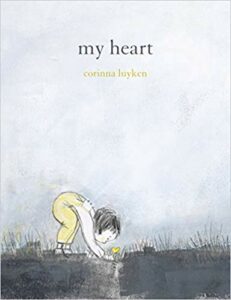 my heart by corinna luyken
my heart by corinna luykenMany of the books on this list are expository in some way, but my heart is a poem set to beautiful illustrations that talks about the many ways the heart can be hurt or grow. It’s a book you can read with very small children, pointing out and talking about what’s happening in the pictures, or gift to older children and even adults to read. When discussing the book you can ask “when has your heart felt bright?” or “what makes your heart feel like it is growing?”
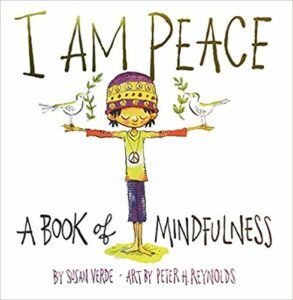 I am Peace by Susan Verde
I am Peace by Susan Verde I love this book for my own children as well as sharing with parents looking for not just words but strategies to teach children how to manage and process big feelings, specifically feelings of anxiety and nervousness. For those that are familiar with the rich traditions of spiritual practices, this book teaches a nice blend of centering and mindfulness. I am Peace is basically Thich Nhat Hanh for children and it’s a lovely reminder for adults as well on how to quiet the mind and center yourself, while quieting anxious thoughts. This read can be a good discussion starter for asking your kids about what makes them worry.
 Big Boys Cry by Jonty Howley
Big Boys Cry by Jonty HowleyThis new release is the book we have needed for our sons, friends, nephews and grandsons to teach an emotional intelligence that combats toxic masculinity. Big Boys Cry teaches that all men cry and for a variety of reasons–joy, sorrow, grief, surprise, laughter. The illustrations are bright and interactive and lead to great conversation about all the different feelings we have and how it’s ok to cry when you are sad.
 When Sadness is at Your Door by Eva Eland
When Sadness is at Your Door by Eva Eland Sadness can be a challenging emotion to understand and process at any age but this sweet book helps readers understand sadness as an emotion that we ought to make our friend, or at the very least become comfortable with its presence as part of our emotional landscape. While When Sadness is at Your Door tackles the abstract experience of sadness, it gives concrete examples for how one ought to treat sadness. I also like how what caused sadness is not addressed–this book can be used for grief and emotional intelligence around a variety of experience.
 A Terrible Thing Happened by Margaret M Holmes
A Terrible Thing Happened by Margaret M HolmesThis book is one pastors and parents should have on hand to give out and use in emergencies. I wished I’d had a stack of a dozen or so in my office to pass out to parents as they came in looking for help and resources. A Terrible Thing Happened is written so that the “terrible thing” that happened is never identified. This means little readers can imagine and place themselves in the story with their own “terrible thing” which means this book can be used for helping young children process anything from the death of a loved one, to abuse, to an act of school violence. Instead of focusing on the terrible thing, the book focuses on how to process and talk about the terrible thing, giving kids concrete coping skills. A Terrible Thing Happened is published through the American Psychological Association and its understanding of human behavior and development shows in the excellent writing and relatable story.
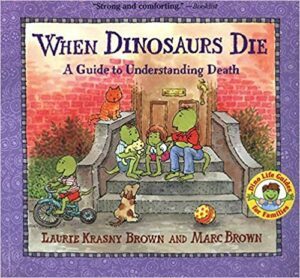 When Dinosaurs Die: A Guide to Understanding Death by Laurie Krasny Brown and Mark Brown
When Dinosaurs Die: A Guide to Understanding Death by Laurie Krasny Brown and Mark BrownThis book is the most comprehensive book in terms of mixing the science of death, with the emotions of death as well as the religious ritual of death. When Dinosaurs Die centers around topics for each page like “why do people die?” and responsibly includes all the reasons for death–military service, poverty, old age, mental health, drug abuse, prejudice and even talks about how the very young sometimes die. Because it is so thorough and inclusive it could be used to help explain to death in many situations, including difficult ones. I also really appreciate that there is a glossary in the back parents can use to explain things surrounding death with age appropriate language–words like “autopsy” and “will” which a child might ask about after overhearing adult conversations.
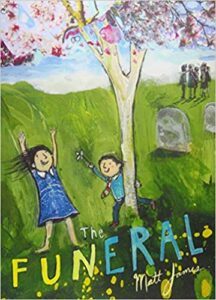 The Funeral by Matt James
The Funeral by Matt JamesThis is a new release and one I wish existed the past 15 years of pastoring with and alongside families in grief. It tells the story of a young girl attending her uncle’s funeral at church and the observations and connections she makes. I am a firm believe that when it is appropriate children should participate in how we make sense of death by attending funerals. The Funeral is the perfect book to introduce to children what to expect–not just what will happen but the mix of feelings they might have.
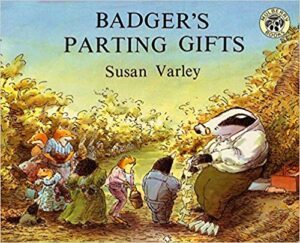 Badgers Parting Gifts by Susan Varlay
Badgers Parting Gifts by Susan VarlayBadger’s Parting Gifts follows a community of animals as they grieve and then slowly remember all the wonderful memories after the death of an older member of their woodland community. This book is a good one for families experiencing the death of a grandparent and teaches kids to reflect as a part of the grief process. It is a bit wordy and would be best used for middle to late elementary aged kids, not preschoolers.
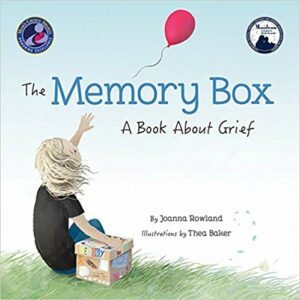 The Memory Box: A Book About Grief by Joanna Rowland
The Memory Box: A Book About Grief by Joanna Rowland What happens to the love and relationship we share with someone who has died? The Memory Box is an award winning book that follows the journey of a young girl as she thinks about how to remember her loved one. This would be a good book to use after the initial shock of death, the funeral and to think through as a family how to honor and remember someone who passed.
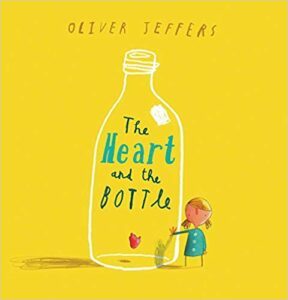 The Heart and the Bottle by Oliver Jeffers
The Heart and the Bottle by Oliver Jeffers Most of the books on this list are geared toward preschoolers through late-elementary and while The Heart in the Bottle is a picture book it is one I would recommend to all ages. Specifically I would recommend this book to middle school and high schoolers, as it presents the abstract concept of keeping your feelings at arms length after the loss of a loved one. It can be used for small children but you will need to ask them questions about the picture and draw connections, because as is true with all Jeffers books the art tells its own subtle story. One of the connection questions I find helpful is “why did she put her heart in a bottle?” “Why did she want to do that?” “What happened when she put her heart and feelings away?” “How can we feel our feelings and not put them away?”
Like what you’ve read? Want more? Sign up for my twice a month newsletter (because we’re not spammy) and get original content you can’t find here on the blog. Reflections on faith and living, book recommendations and other good, nerdy fun. Sign up HERE.
July 15, 2019
Finishing #the100dayproject
I was out with friends last weekend and we were all catching up. I mentioned to my friend who’s a painter and who introduced me to #the100dayproject that I had finished all 100 days. “Whaaaat?!” she replied, “that’s a huge deal, how come you haven’t talked about it anywhere?!”
The truth is that #the100dayproject was so successful for me that I’ve just kept plugging along everyday tending to my creativity and writing. I knew that the finish of the project happened sometime last week (or maybe the week before) but I was content to continue working on my creative project.
Which means that #the100dayproject did exactly what I wanted it to do for my creative life.
As I think about the project, what I accomplished, what worked, what didn’t, what pitfalls I had along the way, I thought I would compile a list of things I learned while doing the project that will help me the next time.
Don’t Worry about Medium
I am a writer but I also paint and use other creative mediums. While my goals for this project were to write more I four out of seven days of the week the first forty days of the project I spent painting. Some people may see this as counter-intuitive, an act of distraction (writers love a good distraction) or unfocused but the painting helped my writing in a few key ways. First, it made the writing I did higher quality the first half when I was painting more. When I sat down I was focused and had if not fully formed, better developed ideas. Second, around the forty day mark something shifted. What I had been working on in my head while I painted became my focus. I abandoned my paintbrushes and took up my keyboard and got to work every day. Writing smaller pieces for the blog, working on larger blog pieces and giving life to a story I have been wanting to tell in the form of a full-fledged manuscript.
The painting fed the creativity if the writing. I learned to not worry about what I was doing each day to meet #the100daychallenge and began to trust that it was all conditioning the same creative muscle. Just like in physical muscle conditioning, you can’t do the same exercise over and over and over again to build the muscle well. You have to do different exercises that all come at the muscle from different approaches.
Tell Someone That Will Cheer for You
Often creative work is a work of solitude. So I told a few friends what I was doing who would understand, ask me about how it was going and generally cheer me on as I tackled #the100dayproject. This is a practice for creativity that extends beyond just this project, but I found it particularly helpful when trying to work 100 days straight to have a few people cheering me on.
It’s also helpful if you live with other people for them to know your goals so they can help create a space and a schedule that allows you to get this work done. Not to mention it’s helpful for them to understand why the dining room table might be overtaken with paint and paint supplies for a solid 100 days!
Have a Plan so You Miss Fewer Days
We did most of our family travel for the year smack in the middle of #the100dayproject. I was worried I would lose my momentum or quit the project all together with most of June being away. Instead, I got a plan together to make creating while traveling possible. I got a sketchbook and a small bag of paint pens, I set up a section in my phone to voice dictate writing ideas and I looked at my time while traveling differently.
At home I get up every morning to write and I paint in the evenings. It’s a pretty set routine but when you travel you don’t have that routine, so I looked for ways to squeeze in a bit of painting here or some writing there. It got done on flights and in car rides, on the tube and in hotel rooms. But having a plan, thinking through what kind of tools would be most successful for the situation and getting them prepped helped me be successful when my schedule was uncertain.
Forgive Yourself for the Missed Days
A few years ago I began the practice of lying in bed at night and forgiving myself for the small things I had done that day and working my way up to the big ones. It was one of the tools I was using to deal with my perfectionism. I was telling a friend about it and how much it was helping when she said “oh that’s the St Ignatius prayer practice!”
When I say I completed #the100daychallenge it means I crossed that finish line of the hundredth day creating. Did I perfectly complete all 100 days? No, I missed a few here and there (I actually found I missed less as the project went on, not more). But the goal of the project is not perfection, but presence to your creative work. To show up and do the work however imperfectly. Forgiving myself for the missed days made it easier to return the next day, not sweating it and for me to finish the project successfully.
Overall would I do #the100dayproject again? Absolutely.
Like what you’ve read? Want more? Sign up for my twice a month newsletter (because we’re not spammy) and get original content you can’t find here on the blog. Reflections on faith and living, book recommendations and other good, nerdy fun. Sign up HERE.
July 3, 2019
Sea Shells and Love
This reflection was originally featured in my twice monthly newsletter but I wanted to share it here.
My daughter’s preschool teacher was away for a week this past fall. She had left the children with great care and intention. Making a countdown calendar so they could be assured how long she would be gone, she wanted the children to be certain of her return. My daughter who still isn’t old enough to tell the difference between “yesterday” and “last weekend” when telling a story came home and told me with precision how long her teacher had been gone and how many days until her return. And much to the surprise and delight of the class when she returned she came bearing gifts. In to each outstretched little hand sitting in their show and tell circle on the Noah’s Ark carpet, she pressed a small white sea shell. “See mom!” my daughter exclaimed as she turned out her pockets before bucking into her carseat “Ms Courtney brought it to us from the water!”
Love is a word that too often is smoothed into a thin, fragile veneer by the hard mallet of bad rom-coms and sappy holiday commercials selling jewelry and cars. The church can be just as bad, speaking of love in such broad terms or with such abstraction it loses the efficacy and nuance that makes it a rich feast instead of a thin broth. Its gets a designated Sunday in Advent, it gets sprinkled around when we talk about neighbors and grace. Sometimes the way we talk about love in the church seems far removed from the bumps and contours of people’s lives, of their family dysfunctions and marriage spats and the kind of love that leaves you worried sick about your children.
But as that small white shell sits upon my counter this week I am reminded that love is among many other things, an assurance of relationship. Love says “people are broken and tricky and trying, but I commit that even in the midst of that holy mess we will remain in relationship.” In the assurance of love we are not promised the magic of relationship but of its mystery. A mystery that engages us in a conversation on what it means to be human and what it takes to be in relationship with imperfect and impermanent things. That is one of the many meanings of baptism in the Christian tradition…that out of the water we can be made new again and again and again. It is a gift and a mystery that comes from the water.
Like what you’ve read? Want more? Sign up for my twice a month newsletter (because we’re not spammy) and get original content you can’t find here on the blog. Reflections on faith and living, book recommendations and other good, nerdy fun. Sign up HERE.
To Have Without Holding
I was away at a board retreat with one of the organizations with whom I work. I was sitting in the garden behind our meeting space during our designated time of silence, a time set aside after the work of the board has been presented to consider what God might be saying in the work before we proceed with business. I was sitting on a bench in the garden staring at the top of a stand of evergreen trees when the line from Marge Piercy’s poem popped into my head.
Learning to love differently is hard,
love with the hands wide open, love
with the doors banging on their hinges,
the cupboard unlocked
The title of the poem is “To have without holding” and as I sat on the cold stone bench noticing the way the shape of the pine branches drooped towards gravity and reached towards light I had the profound sense that I need to release my grip on something in order to enjoy it more. What could God be wanting me to loosen my grip on? My first thought was “well, lots of things you crazy, control freak” but my second thought was something much simpler. So simple it seemed embarrassingly obvious. But that’s the thing about the Spirit, it rarely ever shows up with the wind howling and clattering the doors, it often shows up and nudges our ridiculous egos, presses on the simplest looking things that will disrupt the whole house we’ve built.
As I sat there curious about why on earth Marge Piercy and Jesus would be nudging me to have without holding I began thinking of my children. What was it that I was withholding from them? What is it I could release with hands wide open that could lead to a different kind of love? How could I hold with hands wide open in order to receive more than what I could hold?
And so I sat on the bench rolling around the idea that God was nudging me to have without holding my art supplies. Yes, that’s right, art supplies. You see, in the words of the 90’s rock band we like “to keep it separated”–I have my art supplies, lovely, pristine and organized and my girls have their in a wild, quarterly organized heap on their art cart and never the two shall meet. This is part boundaries and partly that I don’t like to share my things, part hangover for childhood scarcity and part selfishness, part financial practicality and stewardship and part particularity and stubbornness.
And so when I returned home from my trip I thought–why not. Why not share what I was holding on to so tightly and see what happens?
Here’s the thing, I am sure my girls enjoy having access to my art supplies, but the novelty of using mom’s brightly colored, pristine tubes of acrylic paint and painting on canvas has already worn off. They slid with ease back into paper and watercolors, crayons and color books. The release of my control probably meant something to them beyond access to mom’s really rad art supplies, but I might not ever know what it means to them, they are after all their own unique people with their own unique interior lives. But I do know that to have without holding taught me that when I hold lightly, with palms open I can receive more. No, not in the prosperity gospel sense that when you give your money away, more comes back to you. I most definitely have fewer tubes of paint and canvases, but in the sense that when we let go of that which we are grasping at we leave room to receive something more. I have memories now instead of tubes of paint. We have canvases of art that they will never be able to make just like this again–and we have so many of them that we have given them away to friends and family who proudly display them in their homes. When we love this way we end up receiving more than we could ever hold.
Like what you’ve read? Want more? Sign up for my twice a month newsletter (because we’re not spammy) and get original content you can’t find here on the blog. Reflections on faith and living, book recommendations and other good, nerdy fun. Sign up HERE.
June 18, 2019
7 Books for Pride Month Reading
One of the reasons I read is to seek the perspective of people who are different than me–who see and experience the world in geographies, social location and experiences that are different from my own. I find that reading another’s story strengthens your muscles for compassion, empathy and good global citizenship. It’s Pride Month and so I thought I would share a few of the novels, memoirs and theology books that have influenced my head, my heart and the way I live in this world.
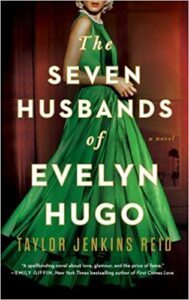 The Seven Husbands of Evelyn Hugo by Taylor Jenkins Reid
The Seven Husbands of Evelyn Hugo by Taylor Jenkins ReidI received The Seven Husbands of Evelyn Hugo via my Book of the Month membership two summers ago and packed it on a weekend getaway to Sedona. I thought by the title and synopsis it would be a light, fun poolside read. It was fun, but it was so much more than a light pool read as it tells the story of the famous Evelyn Hugo and the love life she lived in public to protect the love she held in private. This book was thought provoking and entertaining–my favorite mix!
 The Heart’s Invisible Furies by John Boyne
The Heart’s Invisible Furies by John BoyneJohn Boyne’s The Heart’s Invisible Furies is easily one of my favorite books of all time. I love literary fiction and a multi-decade coming of age story. Add that it takes place in Ireland in the 1950’s and tells the coming of age story of a gay young man and this was by far one of my very favorite reads of 2018. I will also give a quick shout out to Boyne’s other book Ladder to the Sky–if you like despicable protagonists it’s a good one. It’s one where you find yourself not cheering for the main character but cheering for his demise.
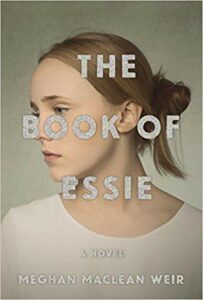 The Book of Essie by Megan MacLean Weir
The Book of Essie by Megan MacLean WeirI loved this little scrappy little novel. The Book of Essie was another Book of the Month pick that I thought would be a light entertaining read. (Did you know that along with telling you the genre, length and synopsis Book of the Month will disclose whether a book is LGBTQ+ friendly, page turner, non-linear timeline, multiple viewpoints and other helpful tips about the books you are selecting from which makes choosing a book that helps you expand your reading to include LGBTQ+ narratives easy) Essie is the teen daughter of a famous conservative Christian reality television family and she’s pregnant. This book could easily fall into tropes or tie up all the issues into one neat, simplistic narrative but instead it leave space for the reader to think through a variety of experiences and ethical dilemmas. I enjoyed cheering for Essie as she navigates a world that only sees her as a ratings and image problem to solve to find her own voice and story.
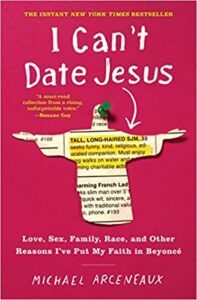 I Can’t Date Jesus by Michael Arceneaux
I Can’t Date Jesus by Michael ArceneauxI have to admit I knew nothing about Michael Arceneuax’s book but I had heard him as a guest on several podcasts I listen to like Keep It and Fresh Air on NPR and was intrigued by his story. And let’s be honest the title of his memoir I Can’t Date Jesus was funny and caught my attention immediately. This was a quick, engaging and entertaining read while still being insightful and moving.
 Fire Shut Up in My Bones by Charles Blow
Fire Shut Up in My Bones by Charles BlowI have read Charles Blow’s column in the New York Times for years, enjoying they way he balanced beautiful prose and a directness about topics that were often new to me. I preordered his memoir Fire Shut Up in My Bones and read it within the month of its arrival. Aside from Blow telling of his upbringing in the rural south, his own coming of age, his writing is breath taking. He is one of those writers that simultaneously makes you want to write more and want to quit writing because you will never be as good.
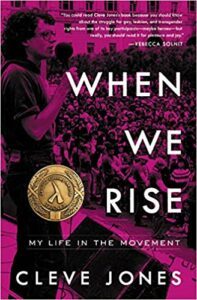 When We Rise: My Life in the Movement by Cleve Jones
When We Rise: My Life in the Movement by Cleve JonesThis book helped me understand more about the movement for civil rights and what it was like during the AIDS crisis. Given how young I am, When We Rise was a helpful education on parts of history that I knew some about but not nearly as much as I should. I am deeply appreciative of this book for helping me stretch and grow.
 The Corinthian Body by Dale E Martin
The Corinthian Body by Dale E MartinThis is an academic book which makes it an odd fit in the midst of novels and memoirs, but Dale Martin’s The Corinthian Body helps people from the Christian tradition answer the questions “what about what the Bible says about human sexuality? Especially Paul?” (because Jesus doesn’t mention human sexuality near as often or specifically like he does wealth). This book takes a look at the context of the socioeconomic strata, bodily and sexual practices of the community on Corinth that Paul wrote to. This book was helpful and enlightening with its handling of the original Greek text and how it has been translated and interpreted out of context of the Corinthian context.
Clearly this is not an all expansive list. I am really curious what books have helped you expand your understanding and knowledge of queer stories and perspectives?
Like what you’ve read? Want more? Sign up for my twice a month newsletter (because we’re not spammy) and get original content you can’t find here on the blog. Reflections on faith and living, book recommendations and other good, nerdy fun. Sign up HERE.
May 29, 2019
20 Childrens Books to Enrich Young Faith
One of my favorite things about being a career long Christian educator and a mother of young children is searching for books that I can use to teach children, my own and others, about the rich nuance, depth and texture of the Christian faith and scriptures. In the rise of bullying and other toxic influences our our children face I find that shaping their character around the teaching of faith urgently important. Books and the conversations that can unfold around them can be used to shape our children’s character and how they live their faith in the world.
Another aspect of Children’s spiritual formation I find urgent is the need for Christian educators be more mindful about creating and utilizing resources that de-center whiteness and tell the stories of faith of all kinds of children and people. It’s not responsible to teach our children that the Middle Eastern and Mediterranean characters of the Bible looked like white Europeans. I also love books that expose my children to different ways of worshiping written from the perspective of other communities within my own faith tradition.
My favorite children’s book on faith and scripture are not books that tell or tie up the story neatly, but rather invite children to imagine the multiple perspectives in the story and consider the complexities of human relationship, so that we can teach children how to navigate those complexities with strong sense of God’s goodness and love. Some are recent releases and some are older but all of them share the common thread of either being books my own children insist on reading over and over and over again or books that I use in teaching children that have encourage good conversation and connections. Here are 20 of my favorite children’s books on Christian faith and scripture.
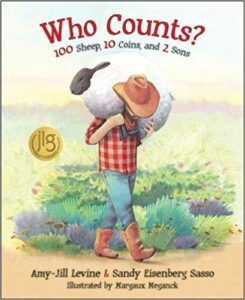 Who Counts? 100 Sheep, 10 Coins and 2 Sons by Amy-Jill Levine and Sandy Eisenberg Sasso
Who Counts? 100 Sheep, 10 Coins and 2 Sons by Amy-Jill Levine and Sandy Eisenberg SassoIf our personal family book collection could be ranked like Billboard, Amy-Jill Levine’s Who Counts? would rank at the top for “most read.” While the concepts and lessons of these stories are engaging for elementary aged children, this book captivated my three year old’s attention. It takes the stories of the lost sheep, lost coin and two sons and ties them together in a single visual and theological thread the way that Jesus told them.
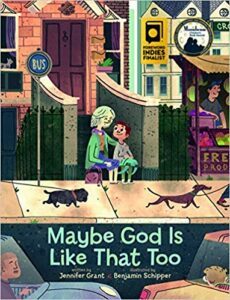 Maybe God is Like that Too by Jennifer Grant
Maybe God is Like that Too by Jennifer GrantSeeing God at work in the world is such an abstract concept to teach kids but with Maybe God is Like that Too Jennifer Grant helps young readers see how our everyday actions and interactions can be the presence of God. This book encourages young readers to see God in lots of different ways and I love using it at bedtime to ask my kids about their day–where they saw God at work and how they could have showed up to be God’s presence to someone else in the day.
 Early Sunday Morning by Denene Milner
Early Sunday Morning by Denene MilnerThere are rare Sunday mornings where my family moves slowly and feels reluctant to dress up, load in the car and drive across town to church but once we arrive in the presence of our beloved community and fall into our rhythm that all melts away. Early Sunday Morning is brightly illustrated book about the rhythms and joy of Sunday morning at church and a fun way to talk as a family or in Sunday School about why we gather and what it means to us.
 When God Made You by Matthew Paul Turner
When God Made You by Matthew Paul TurnerThis is not the only Matthew Paul Turner on this list, in fact all of his children’s books have made this list. I order this book for expectant parents as part of their baby gift, I give it to new parents in the church, I make sure every church I work with has a copy in the nursery and I have a colleague that gives this book to new parents at baby dedications or baptisms (depending on your tradition). When God Made You is a wonderful message with creative illustrations to teach and instill in young children their inherent worth in God’s eyes.
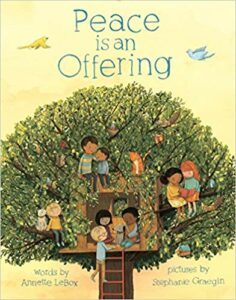 Peace is an Offering by Annette LeBox
Peace is an Offering by Annette LeBoxThis book teaches children how everyday actions can sow seeds of peace in their neighborhood. Peace is an Offering connects the everyday to the holy, inviting readers to make connections to small deeds to holy action. The illustrations in this book are sweet and joyful and we love talking about being people who value peacemaking as part of what our faith teaches us.
 A Church for All by Gayle E Pitman
A Church for All by Gayle E PitmanI saw this book an Here Wee Read‘s Instagram feed months before this book released and eagerly anticipated its arrival on my doorstep. It’s an easy book that uses accessible language and vivid illustrations of all the different kinds of people who are welcome at church. I love that this book includes bodies of all different shapes, color, ability and family structures to not just tell that church is for everyone but visually show children. A Church for All is mandatory book for church nurseries and worship spaces.
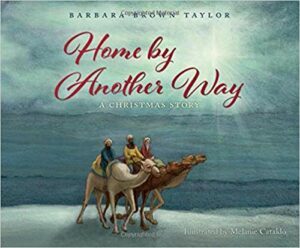 Home by Another Way: A Christmas Story by Barbara Brown Taylor
Home by Another Way: A Christmas Story by Barbara Brown TaylorBarbara Brown Taylor is known for her writing around spiritual formation and pastoral leadership. With Home by Another Way Brown Taylor reframes the story of the wisemen to imagine their interactions with Herod, Mary and Joseph and the baby Jesus and how they encounters shaped them. The illustrations are beautiful but it is the story telling that sets it apart amongst its Christmas storybook peers.
 Nativity by Cynthia Rylant
Nativity by Cynthia RylantEvery year we wrap books and unwrap and read one as part of our Advent practice. I purchased this book this past Advent and was delightfully surprised by the unexpected twist in this book. Rylant uses the story of the birth of Jesus to talk about the Beatitudes from Jesus’s Sermon on the Mount. Nativity makes for a resource that connects the birth of Jesus with the life and ministry of Jesus. It makes for a helpful resource in Advent, Lent or in Ordinary Time. But what I most love is that it makes the abstract teaching of the Beatitudes tangible for young readers.
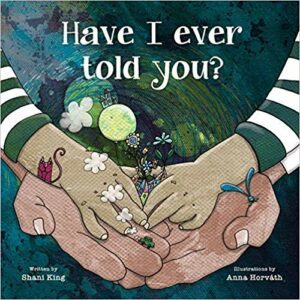 Have I Ever Told You? by Shani King
Have I Ever Told You? by Shani KingSometimes children’s books are also helpful instructional tools for the grown ups in their lives. Have I Ever Told You? is a lovely book of affirmation and blessings. This book is not overtly religious but I love the way it can encourage conversations with kids about the things that matter. I would LOVE to use this book during an intergenerational teaching during Sunday School or family retreat to teach about how we bless the people we love and we encounter with our words and then things we tell them about themselves.
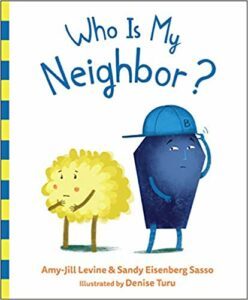 Who Is My Neighbor? by Amy-Jill Levine & Sandy Eisenberg Sasso
Who Is My Neighbor? by Amy-Jill Levine & Sandy Eisenberg SassoAnother instant classic at our house, Who Is My Neighbor? imagines the story traditionally referred to as “The Good Samaritan” in a way that connects to small children. The yellows and the blues live in separate communities and are suspicious of their different ways of living–different songs, different foods, etc. But then an accident occurs and a blue and yellow are forced to see each other and their communities differently. A sweet and accessible book for all ages to understand the story with a fresh perspective on a timeless classic.
 When I Pray for You by Matthew Paul Turner
When I Pray for You by Matthew Paul TurnerI love using prayer stations to teach all ages. When I Pray for You can be used with preschoolers and families to introduce and teach the practice of intercessory prayer. This book could easily be paired with a lesson on all the places and ways that we pray and used with preschoolers through early elementary aged kids, as it talks about all the ways that a parent prays for a child. It can also be used by families at home to start a conversation on family values, hopes and dreams. When I read this book to my little ones I like to ask them “do you know what I pray for you?” and then share all those kind things I want to sew into their hearts. Sometimes I will flip it and ask “what do we pray for grandma?” or some other friend or relative as a way of helping them expand their sense of compassion and mindfulness for others.
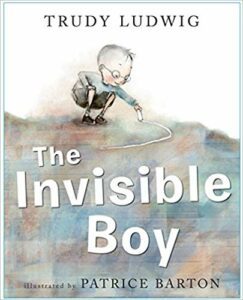 The Invisible Boy by Trudy Ludwig
The Invisible Boy by Trudy LudwigThis children’s book is not overtly faith based but it is none the less an excellent teaching tool for faith. It follows a boy that is quieter than his classmates and often overlooked who discovers the gift of being seen through friendship. I have used this book to teach children when they were anticipating a new pastor’s arrival, when teaching how to create welcoming space at school, with Promotion Sunday and in a lesson on noticing people in their community who might need God’s love to shine through them. Bonus? In the back of The Invisible Boy the author has created conversation suggestions for parents and educators to use to open the story up and drive home points with little ones.
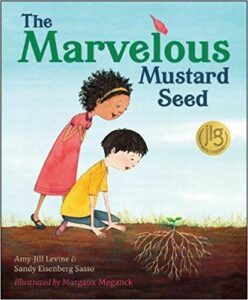 The Marvelous Mustard Seed by Amy-Jill Levine and Sandy Eisenberg Sasso
The Marvelous Mustard Seed by Amy-Jill Levine and Sandy Eisenberg SassoI am always appreciative of books that can imaginatively tell a Biblical story without compromising the theological integrity. The Marvelous Mustard Seed book has theological integrity and opens the story up to be considered in new ways. It’s not just a favorite of my children but it is a personal favorite of mine. This book has cracked open new ideas for preaching and personal study that I didn’t previously see in the original Parable of the Mustard Seed.
 He’s Got the Whole World in His Hands by Kadir Nelson
He’s Got the Whole World in His Hands by Kadir NelsonKadir Nelson’s art work is prolific and captivating as he captures “the personal and collective stories of people.” He’s Got the Whole World in His Hands uses a mix of classic and fresh lyrics to the old children song, illustrates the song in a way that captures little (and big) imaginations. While the language is not inclusive, at our house we just read it with inclusive language to our little ones. And what little inclusive editing we do is well worth the captivating story telling that Nelson’s art is known for as it is applied to this classic. We love singing the song and talking about the illustrations as a calming part of our bedtime ritual. This is a great addition to your church nursery or as part of a baby gift to expectant parents.
 The World is Awake: A Celebration of Everyday Blessings by Linsey Davis
The World is Awake: A Celebration of Everyday Blessings by Linsey DavisKids see beauty and blessings in every day, but often don’t have the words to share those moments. Our dinner questions are about “what beauty and struggle did you experience today?” “Where did you see God in your actions or others?” The World is Awake helps connect what kids see in the world with how to talk about those everyday blessings. It can also be used to talk about God’s creation and all the ways that God shows up through the creation. The illustrations are bright and accessible for younger kids.
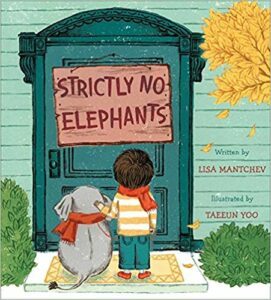 Strictly No Elephants by Lisa Mantchev
Strictly No Elephants by Lisa MantchevThis book has been a classic in our house for years, because it combines teaching inclusion and kindness with lots of really cute and creative pets. There is a pet club, but they only allow traditional pets and specifically NO ELEPHANTS. So the kids with all the non-traditional pets like skunks and narwhales and elephants start a pet club where everyone is welcome. Strictly No Elephants books is simple but NOT simplistic, there is a subplot that runs through it about what it means to be a friend and care for one another that runs under the plot about inclusion.
 Paul Writes (A Letter) by Chris Raschka
Paul Writes (A Letter) by Chris RaschkaThis book is quite unique and I was grateful to add it to my resources. Paul Writes (A Letter) tells about the apostle Paul and how he wrote letters to the different churches. It summarizes each letter in a way kids can understand and uses the letters to explain that writing about faith can be a ministry (which obviously I love). I used this book in a Sunday School lesson where we learned about Paul and his conversion story, we had a fun exercise where we wrote (or dictated depending on age level) letters to our friends and classmates telling them about God.
 When God Made Light by Matthew Paul Turner
When God Made Light by Matthew Paul TurnerI love this book for the way that it uses the worlds from the creation story to launch into an imaginative, lyrical and beautifully illustrated story about God’s light in us and shining into the difficult places in our world. When God Made Light is a favorite in our home and one I use as a pastoral resource to help kids who are struggling with grief, fear and anxiety.
 I Am Peace: A Book fo Mindfulness by Susan Verde
I Am Peace: A Book fo Mindfulness by Susan VerdeThis is an excellent book to use to introduce meditation into a Sunday School or Children’s Church lesson. I have used it to teach the beatitudes, the Psalms and Fruits of the Spirit. While I Am Peace is not an explicitly faith based book or Christian, it teaches the fundamentals of centering your mind and heart to receive the world in all its beauty.
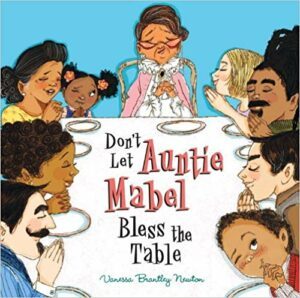 Don’t Let Auntie Mabel Bless the Table by Vanessa Newton
Don’t Let Auntie Mabel Bless the Table by Vanessa NewtonThis is one of our favorite books, it’s silly and playful and the illustrations are well done and full of joy. It is also a great example of communal prayer and building intergenerational community in families. Don’t Let Auntie Mabel Bless the Table is accessible for toddlers and up as its brief but fun rhyming style keeps the story moving.
What titles are your family favorites?
Like what you’ve read? Want more? Sign up for my twice a month newsletter (because we’re not spammy) and get original content you can’t find here on the blog. Reflections on faith and living, book recommendations and other good, nerdy fun. Sign up HERE.
20 Children’s Book to Enrich Young Faith
One of my favorite things about being a career long Christian educator and a mother of young children is searching for books that I can use to teach children, my own and others, about the rich nuance, depth and texture of the Christian faith and scriptures. In the rise of bullying and other toxic influences our our children face I find that shaping their character around the teaching of faith urgently important. Books and the conversations that can unfold around them can be used to shape our children’s character and how they live their faith in the world.
Another aspect of Children’s spiritual formation I find urgent is the need for Christian educators be more mindful about creating and utilizing resources that de-center whiteness and tell the stories of faith of all kinds of children and people. It’s not responsible to teach our children that the Middle Eastern and Mediterranean characters of the Bible looked like white Europeans. I also love books that expose my children to different ways of worshiping written from the perspective of other communities within my own faith tradition.
My favorite children’s book on faith and scripture are not books that tell or tie up the story neatly, but rather invite children to imagine the multiple perspectives in the story and consider the complexities of human relationship, so that we can teach children how to navigate those complexities with strong sense of God’s goodness and love. Some are recent releases and some are older but all of them share the common thread of either being books my own children insist on reading over and over and over again or books that I use in teaching children that have encourage good conversation and connections. Here are 20 of my favorite children’s books on Christian faith and scripture.
 Who Counts? 100 Sheep, 10 Coins and 2 Sons by Amy-Jill Levine and Sandy Eisenberg Sasso
Who Counts? 100 Sheep, 10 Coins and 2 Sons by Amy-Jill Levine and Sandy Eisenberg SassoIf our personal family book collection could be ranked like Billboard, Amy-Jill Levine’s Who Counts? would rank at the top for “most read.” While the concepts and lessons of these stories are engaging for elementary aged children, this book captivated my three year old’s attention. It takes the stories of the lost sheep, lost coin and two sons and ties them together in a single visual and theological thread the way that Jesus told them.
 Maybe God is Like that Too by Jennifer Grant
Maybe God is Like that Too by Jennifer GrantSeeing God at work in the world is such an abstract concept to teach kids but with Maybe God is Like that Too Jennifer Grant helps young readers see how our everyday actions and interactions can be the presence of God. This book encourages young readers to see God in lots of different ways and I love using it at bedtime to ask my kids about their day–where they saw God at work and how they could have showed up to be God’s presence to someone else in the day.
 Early Sunday Morning by Denene Milner
Early Sunday Morning by Denene MilnerThere are rare Sunday mornings where my family moves slowly and feels reluctant to dress up, load in the car and drive across town to church but once we arrive in the presence of our beloved community and fall into our rhythm that all melts away. Early Sunday Morning is brightly illustrated book about the rhythms and joy of Sunday morning at church and a fun way to talk as a family or in Sunday School about why we gather and what it means to us.
 When God Made You by Matthew Paul Turner
When God Made You by Matthew Paul TurnerThis is not the only Matthew Paul Turner on this list, in fact all of his children’s books have made this list. I order this book for expectant parents as part of their baby gift, I give it to new parents in the church, I make sure every church I work with has a copy in the nursery and I have a colleague that gives this book to new parents at baby dedications or baptisms (depending on your tradition). When God Made You is a wonderful message with creative illustrations to teach and instill in young children their inherent worth in God’s eyes.
 Peace is an Offering by Annette LeBox
Peace is an Offering by Annette LeBoxThis book teaches children how everyday actions can sow seeds of peace in their neighborhood. Peace is an Offering connects the everyday to the holy, inviting readers to make connections to small deeds to holy action. The illustrations in this book are sweet and joyful and we love talking about being people who value peacemaking as part of what our faith teaches us.
 A Church for All by Gayle E Pitman
A Church for All by Gayle E PitmanI saw this book an Here Wee Read‘s Instagram feed months before this book released and eagerly anticipated its arrival on my doorstep. It’s an easy book that uses accessible language and vivid illustrations of all the different kinds of people who are welcome at church. I love that this book includes bodies of all different shapes, color, ability and family structures to not just tell that church is for everyone but visually show children. A Church for All is mandatory book for church nurseries and worship spaces.
 Home by Another Way: A Christmas Story by Barbara Brown Taylor
Home by Another Way: A Christmas Story by Barbara Brown TaylorBarbara Brown Taylor is known for her writing around spiritual formation and pastoral leadership. With Home by Another Way Brown Taylor reframes the story of the wisemen to imagine their interactions with Herod, Mary and Joseph and the baby Jesus and how they encounters shaped them. The illustrations are beautiful but it is the story telling that sets it apart amongst its Christmas storybook peers.
 Nativity by Cynthia Rylant
Nativity by Cynthia RylantEvery year we wrap books and unwrap and read one as part of our Advent practice. I purchased this book this past Advent and was delightfully surprised by the unexpected twist in this book. Rylant uses the story of the birth of Jesus to talk about the Beatitudes from Jesus’s Sermon on the Mount. Nativity makes for a resource that connects the birth of Jesus with the life and ministry of Jesus. It makes for a helpful resource in Advent, Lent or in Ordinary Time. But what I most love is that it makes the abstract teaching of the Beatitudes tangible for young readers.
 Have I Ever Told You? by Shani King
Have I Ever Told You? by Shani KingSometimes children’s books are also helpful instructional tools for the grown ups in their lives. Have I Ever Told You? is a lovely book of affirmation and blessings. This book is not overtly religious but I love the way it can encourage conversations with kids about the things that matter. I would LOVE to use this book during an intergenerational teaching during Sunday School or family retreat to teach about how we bless the people we love and we encounter with our words and then things we tell them about themselves.
 Who Is My Neighbor? by Amy-Jill Levine & Sandy Eisenberg Sasso
Who Is My Neighbor? by Amy-Jill Levine & Sandy Eisenberg SassoAnother instant classic at our house, Who Is My Neighbor? imagines the story traditionally referred to as “The Good Samaritan” in a way that connects to small children. The yellows and the blues live in separate communities and are suspicious of their different ways of living–different songs, different foods, etc. But then an accident occurs and a blue and yellow are forced to see each other and their communities differently. A sweet and accessible book for all ages to understand the story with a fresh perspective on a timeless classic.
 When I Pray for You by Matthew Paul Turner
When I Pray for You by Matthew Paul TurnerI love using prayer stations to teach all ages. When I Pray for You can be used with preschoolers and families to introduce and teach the practice of intercessory prayer. This book could easily be paired with a lesson on all the places and ways that we pray and used with preschoolers through early elementary aged kids, as it talks about all the ways that a parent prays for a child. It can also be used by families at home to start a conversation on family values, hopes and dreams. When I read this book to my little ones I like to ask them “do you know what I pray for you?” and then share all those kind things I want to sew into their hearts. Sometimes I will flip it and ask “what do we pray for grandma?” or some other friend or relative as a way of helping them expand their sense of compassion and mindfulness for others.
 The Invisible Boy by Trudy Ludwig
The Invisible Boy by Trudy LudwigThis children’s book is not overtly faith based but it is none the less an excellent teaching tool for faith. It follows a boy that is quieter than his classmates and often overlooked who discovers the gift of being seen through friendship. I have used this book to teach children when they were anticipating a new pastor’s arrival, when teaching how to create welcoming space at school, with Promotion Sunday and in a lesson on noticing people in their community who might need God’s love to shine through them. Bonus? In the back of The Invisible Boy the author has created conversation suggestions for parents and educators to use to open the story up and drive home points with little ones.
 The Marvelous Mustard Seed by Amy-Jill Levine and Sandy Eisenberg Sasso
The Marvelous Mustard Seed by Amy-Jill Levine and Sandy Eisenberg SassoI am always appreciative of books that can imaginatively tell a Biblical story without compromising the theological integrity. The Marvelous Mustard Seed book has theological integrity and opens the story up to be considered in new ways. It’s not just a favorite of my children but it is a personal favorite of mine. This book has cracked open new ideas for preaching and personal study that I didn’t previously see in the original Parable of the Mustard Seed.
 He’s Got the Whole World in His Hands by Kadir Nelson
He’s Got the Whole World in His Hands by Kadir NelsonKadir Nelson’s art work is prolific and captivating as he captures “the personal and collective stories of people.” He’s Got the Whole World in His Hands uses a mix of classic and fresh lyrics to the old children song, illustrates the song in a way that captures little (and big) imaginations. While the language is not inclusive, at our house we just read it with inclusive language to our little ones. And what little inclusive editing we do is well worth the captivating story telling that Nelson’s art is known for as it is applied to this classic. We love singing the song and talking about the illustrations as a calming part of our bedtime ritual. This is a great addition to your church nursery or as part of a baby gift to expectant parents.
 The World is Awake: A Celebration of Everyday Blessings by Linsey Davis
The World is Awake: A Celebration of Everyday Blessings by Linsey DavisKids see beauty and blessings in every day, but often don’t have the words to share those moments. Our dinner questions are about “what beauty and struggle did you experience today?” “Where did you see God in your actions or others?” The World is Awake helps connect what kids see in the world with how to talk about those everyday blessings. It can also be used to talk about God’s creation and all the ways that God shows up through the creation. The illustrations are bright and accessible for younger kids.
 Strictly No Elephants by Lisa Mantchev
Strictly No Elephants by Lisa MantchevThis book has been a classic in our house for years, because it combines teaching inclusion and kindness with lots of really cute and creative pets. There is a pet club, but they only allow traditional pets and specifically NO ELEPHANTS. So the kids with all the non-traditional pets like skunks and narwhales and elephants start a pet club where everyone is welcome. Strictly No Elephants books is simple but NOT simplistic, there is a subplot that runs through it about what it means to be a friend and care for one another that runs under the plot about inclusion.
 Paul Writes (A Letter) by Chris Raschka
Paul Writes (A Letter) by Chris RaschkaThis book is quite unique and I was grateful to add it to my resources. Paul Writes (A Letter) tells about the apostle Paul and how he wrote letters to the different churches. It summarizes each letter in a way kids can understand and uses the letters to explain that writing about faith can be a ministry (which obviously I love). I used this book in a Sunday School lesson where we learned about Paul and his conversion story, we had a fun exercise where we wrote (or dictated depending on age level) letters to our friends and classmates telling them about God.
 When God Made Light by Matthew Paul Turner
When God Made Light by Matthew Paul TurnerI love this book for the way that it uses the worlds from the creation story to launch into an imaginative, lyrical and beautifully illustrated story about God’s light in us and shining into the difficult places in our world. When God Made Light is a favorite in our home and one I use as a pastoral resource to help kids who are struggling with grief, fear and anxiety.
 I Am Peace: A Book fo Mindfulness by Susan Verde
I Am Peace: A Book fo Mindfulness by Susan VerdeThis is an excellent book to use to introduce meditation into a Sunday School or Children’s Church lesson. I have used it to teach the beatitudes, the Psalms and Fruits of the Spirit. While I Am Peace is not an explicitly faith based book or Christian, it teaches the fundamentals of centering your mind and heart to receive the world in all its beauty.
 Don’t Let Auntie Mabel Bless the Table by Vanessa Newton
Don’t Let Auntie Mabel Bless the Table by Vanessa NewtonThis is one of our favorite books, it’s silly and playful and the illustrations are well done and full of joy. It is also a great example of communal prayer and building intergenerational community in families. Don’t Let Auntie Mabel Bless the Table is accessible for toddlers and up as its brief but fun rhyming style keeps the story moving.
Like what you’ve read? Want more? Sign up for my twice a month newsletter (because we’re not spammy) and get original content you can’t find here on the blog. Reflections on faith and living, book recommendations and other good, nerdy fun. Sign up HERE.
May 22, 2019
The Layers by Stanley Kunitz
The Layers by Stanley Kunitz
I have walked through many lives,
some of them my own,
and I am not who I was,
though some principle of being
abides, from which I struggle
not to stray.
When I look behind,
as I am compelled to look
before I can gather strength
to proceed on my journey,
I see the milestones dwindling
toward the horizon
and the slow fires trailing
from the abandoned camp-sites,
over which scavenger angels
wheel on heavy wings.
Oh, I have made myself a tribe
out of my true affections,
and my tribe is scattered!
How shall the heart be reconciled
to its feast of losses?
In a rising wind
the manic dust of my friends,
those who fell along the way,
bitterly stings my face.
Yet I turn, I turn,
exulting somewhat,
with my will intact to go
wherever I need to go,
and every stone on the road
precious to me.
In my darkest night,
when the moon was covered
and I roamed through wreckage,
a nimbus-clouded voice
directed me:
“Live in the layers,
not on the litter.”
Though I lack the art
to decipher it,
no doubt the next chapter
in my book of transformations
is already written.
I am not done with my changes.
Like what you’ve read? Want more? Sign up for my twice a month newsletter (because we’re not spammy) and get totally original content you can’t find here on the blog. Sign up HERE.
Spring 2019 Reading Recap
Spring is always a different kind of reading season for me. Normally my reading slows as I spend my time in the yard cleaning, cutting and mulching so that I can enjoy reading and relaxing in that space all summer and fall. This spring I have been head down on three distinct projects: finishing well with a consulting client, starting a new manuscript and working my way through #the100dayproject.
Given all these joyous and time absorbing projects I decided to do a spring reading recap instead of monthly recaps, so that the very best of what I was reading could be highlighted.
March Reads
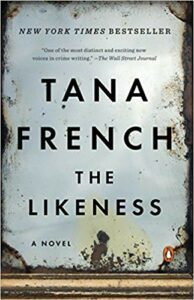 The Dublin Murder Squad Series by Tana French
The Dublin Murder Squad Series by Tana FrenchThis month I decided that I would start at the beginning of Tana French’s Dublin Murder Squad series, having read and enjoyed The Trespassers last year and The Witch Elm having caught my eye this year. Let’s just say I am in deep! I cannot get enough of the Murder Squad team with all it’s quirks and intricacies. French knows how to build a world and I love how she writes strong, thoughtful female protagonists. I also love how she shifts which characters are the focus of each book so that you don’t HAVE to read them all or in order. So far The Likeness has been my favorite in this series.
 Daisy Jones and the Six by Taylor Jenkins Reid
Daisy Jones and the Six by Taylor Jenkins ReidI loved The Seven Husbands of Evelyn Hugo when I read it in 2017 and have been anticipating Taylor Jenkins Reid’s newest book Daisy Jones and the Six since I learned of it’s upcoming release. It had the same salaciousness of Eveyln Hugo as well as the characters who’s motives were complex, relatable and tricky. It’s really hard to talk about this book without comparing it to Evelyn Hugo (in my mind) but it was witty, face paced and enjoyable, although did not have a surprising depth that I enjoy from Evelyn Hugo.
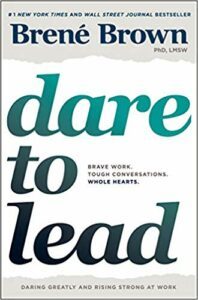 Dare to Lead by Brene Brown
Dare to Lead by Brene BrownI listened to this on audiobook driving to and from one of my consulting clients in Dallas and found it very helpful and informative. The Gifts of Imperfection and Daring Greatly are the two Brene Brown books that have created the most impact on my own life and ministry. Dare to Lead pulls together so many of the helpful threads of previous books and applies them directly to how we lead the groups, relationships and organizations we engage with with intension and integrity. There are specific and tactical take aways as well as broader conceptual ideas about how to lead.
April Reads
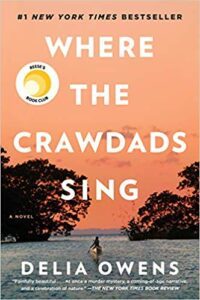 Where the Crawdads Sing by Delia Owens
Where the Crawdads Sing by Delia OwensAny book that sits on the NYTimes bestseller list for this long catches my attention. But what motivated me to move Where the Crawdads Sing up my TBR list was an interview with Delia Owens where she talked about how she could write so fluently about loneliness because she had know loneliness intimately. Where the Crawdads Sing was a story that captured me in ways that books rarely do. Kya’s life on the edge of civilization, left to find her way was tragic but captivating in her resilience. Owens also has a profound sense of place in this book–I have never been to the areas of the south she sets the book in but I felt completely connected to the place where Kya’s story was set. I found this book completely worthy of all the praise.
 Big Magic by Elizabeth Gilbert
Big Magic by Elizabeth GilbertEveryone has recommend Big Magic: Creative Living Beyond Fear, but I was resistant. Often books on creativity either lack substance and could have been better published as a pamphlet or power point presentation or are so specific to the writer and their craft that its hard to really make a connection to the advice. However, my friend and painter Andrea recommended this book so persistently to me that I finally checked it out from the library as an audiobook. It was the perfect thing to listen to as I painted and wrote this month–it was like Elizabeth Gilbert was giving me my own pep-talk on creativity. I will also add that there are about 10 different sermons in this book about creativity, creation and the work of the Spirit, for those of you who are minister-y types.
May Reads
 The Death of Mrs Westaway by Ruth Ware
The Death of Mrs Westaway by Ruth WareSeveral of the moms at my daughter’s dance studio are also voracious readers. Which is awesome because sometimes we swap books or make recommendations. The Death of Mrs Westaway wasn’t even on my radar until one of the dance moms recommended it to me! This was another book that I read via audiobook and thoroughly enjoyed listening to while working on my #the100dayproject in the evenings and on my commute. I found Hal’s dilemma both relatable and perplexing and the Westaways a fascinating family to step into the midst of as a reader.
 When Breath Becomes Air by Paul Kalanithi
When Breath Becomes Air by Paul KalanithiI am working on a new manuscript (hello honeymoon phase where everything is fun and exciting and yet to become a slog you never want to look at again) and picked this up to read for that project. While small, it was thoughtful and impactful reflection on death and dying. At the release of When Breath Becomes Air it was met much acclaim, I grabbed a copy to read as a church pastor but didn’t get around to reading it until this project.
Like what you’ve read? Want more? Sign up for my twice a month newsletter (because we’re not spammy) and get totally original content you can’t find here on the blog. Sign up HERE.



